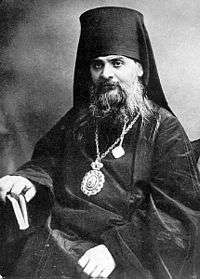Hermogenes (Dolganyov)
| Hermogenes, Bishop of Tobolsk and Siberia | |
|---|---|
 | |
| Born |
April 25, 1858 Kherson Governorate |
| Died |
June 16, 1918 (aged 60) Tura River |
Georgiy Yefremovich Dolganyov (Георгий Ефремович Долганёв); 1858, Kherson Governorate – 15 June 1918) was a prominent Russian Orthodox religious figure and a monarchist with extreme right ideas, supporting the Union of the Russian People and Black Hundreds. In 1917, he was appointed as Hermogenes, Bishop of Tobolsk and Siberia (Russian: священномученик Гермоген, епископ Тобольский и Сибирский). The Archbishop was canonized on 31 March 1999 being regarded as a Saint martyr.
Life
Georgiy, the son of a priest, went to school in Ananyev,[1] a city (near Odessa) where half of the population was Jewish. He studied law, mathematics and philology at Novorossiysk University. (Because of his high-pitched voice, it was believed Hermogenes had castrated himself in 1890,[2] influenced by the ideas of the Skoptsy).[3] Influenced by Nicanor, Bishop of Kherson, he chose the Orthodox ministry. Following his education in Saint Petersburg Theological Seminary in 1892, Dolganyov accepted the name Hermogenes. In 1893 he became the inspector of the Tiflis Theological Seminary in Tbilisi, and in 1898 became its dean. In 1899, Hermogenes was responsible for expelling one of seminary's most famous students, Joseph Dzhugashvili (Joseph Stalin), who had been reading Ninety-Three (a book on the French Revolution by Victor Hugo) and lecturing students on Marxism.[4] In 1903 he became the Bishop of Saratov and Tsaritsyn and had a seat in the Holy Synod. In the church he introduced singing by the people, promoted processions, founded schools, and started mission work. Hermogenes founded the Annunciation Convent and Saint Trinity Monastery in Khvalynsk, in Volsk the Town Church of Annunciation.[5]

In 1905, Hermogenes, probably the most widely respected figure in the Russian Orthodox Church,[6] became a friend of Grigori Rasputin from the time he arrived in the capital.[7] Rasputin stayed at Alexander Nevsky Lavra; there he met with Hermogenes and Theophanes of Poltava, who were amazed with his psychological perspicacity. For a time, Bishop Hermogen and Rasputin became allies in the struggle against freethinking and modernism.[8] His rhetoric was so outrageous that local officials suppressed the newspaper of his diocese.[9] In 1909, Rasputin visited Hermogen in Saratov and Iliodor in Tsaritsyn.[9] Within two years the three men became bitter enemies.
In December 1911, Hermogenes and Iliodor came into conflict with Rasputin, who chose a different strategy and had almost free access to the Imperial family. Hermogen started rumours that Rasputin had joined the Khlysty, an obscure Christian sect with strong Siberian roots. After having been beaten by Hermogen,[10] in a monastery on Vasilyevsky Island, Rasputin complained to the Imperial couple. Within a few weeks and without a trial, Hermogenes and his assistant Mitya Kozelsky, a holy fool, were expelled to the Zhyrovichy Monastery.[11]
From August 1915 he lived in Ugresha Monastery. In 1917 he was appointed as Archbishop of Tobolsk and Siberia. He established contacts with the Imperial Family in Ekaterinburg.[12] In April 1918 Hermogenes was arrested by Bolsheviks and drowned in the Tura River, not far from the birthplace of his nemesis Rasputin. His body was found on 3 July and buried in a nearby village, then reburied in the Sophia cathedral of Tobolsk.[13]
References
- ↑ Гермоген (Долганов)
- ↑ Simon Dixon (2010) The 'Mad Monk' Iliodor in Tsartisyn, p. 388
- ↑ J.T. Fuhrmann (2013) "The Untold Story", p. 69.
- ↑ Isaac Deutscher (1949) "Stalin. A Political Biography"
- ↑ Гермоген, епископ Тобольский священномученик (in Russian). Retrieved 2007-06-12.
- ↑ J.T. Fuhrmann (2013), p. 83
- ↑ E. Radzinsky (2010) The Rasputin File, p
- ↑ THE LIFE AND DEATH OF RASPUTIN by Vladimir Moss
- 1 2 J. T. Fuhrmann, p. 69.
- ↑ Out of My Past: Memoirs of Count Kokovtsov, p. 293. ; Felix Yusupov (1952) Lost Splendor
- ↑ M. Nelipa (2010) The Murder of Grigorii Rasputin. A Conspiracy That Brought Down the Russian Empire, p. 37–38; J.T. Fuhrmann (2013) "The Untold Story", p. 84; Charles A. Ruud Sergei Stepanov (1999) Fontanka 16: The Tsars' Secret Police, p. 295–296. .
- ↑ M. Nelipa (2010), p. 551.
- ↑ О канонизации Священномученика Гермогена Долганева (1858-1918) Епископа Тобольского и Сибирского
Sources
- Fuhrmann, Joseph T. (2013). Rasputin, the untold story (illustrated ed.). Hoboken, New Jersey: John Wiley & Sons, Inc. p. 314. ISBN 978-1-118-17276-6.